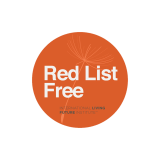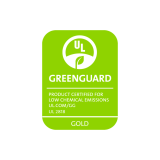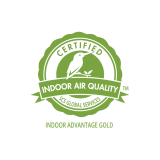

Choosing Joint Sealants that Minimize Health Hazards
A sealant goes in between two different substrates (wood, glass, metal, brick, etc.) and joins them together. Their job is to fill a gap—often at a place where two building elements need to be joined together—and form a barrier. They help prevent structural damage from materials entering joints, help prevent mold development, and function as an air and water barrier. They also must, depending on the materials being joined and the location of the structure, have some degree of elasticity to allow for the impact of heating and cooling and seismic movement.
What about caulk? Caulks are considered a joint sealant, but there is a distinction. Sealants are considered high performing materials with a high level of elasticity that allows for shrinking , expansion, and high weatherability while maintaining its job as a continuous barrier between substrates. Caulks have much less elasticity. They create a paintable surface by filling a space where there are gaps or penetrations. Caulks include acrylic and latex sealants, are water-based, and contain fewer hazardous chemicals than other heavier duty sealants. They still prevent moisture and air passage, but they last for a shorter period of time before needing re-application.
Sealants that react onsite are the most hazardous and should be avoided whenever possible. Polyurethane products contain hazardous isocyanates, which are described as a leading cause of workplace asthma. It is also common for sealants to contain endocrine-disrupting plasticizers called phthalates. Additionally, beware of products claiming to contain antimicrobial agents and fungicides. As with most products, it is recommended to choose products that are low VOC and that carry a third party certification such as GREENGUARD Gold. Products with less than 50 g/L are considered low VOC, though products under 25 g/L of VOCs are preferred.
Information in this section draws from and adapts the work of Habitable. Visit Habitable’s Informed website for the most updated guidance.
Healthier Joint Sealants
Look for these labels:



| Joint Sealant Type | Application | Chemicals of Concern | Health Hazards | Guidance |
|---|---|---|---|---|
| Pre-compressed polyurethane foam tape | Good for sealing gaps around walls, windows and doors- and where final joint will be visible | Mostly safe, but in the rare case, flame retardant TCPP may be added | Endocrine disruption; asthma trigger; developmental harm | Check with manufacturer that product does not contain halogenated flame retardants |
| Acrylic and latex caulk | Best for interior applications and those requiring painting, also works for exterior and to seal windows and doors | Most ingredient content is safe, but may include additives such as ethylene glycol and Stoddard solvent | Birth defects, developmental harm, cancer, gene mutations | Ask the manufacturer to disclose plasticizers and make sure the product is phthalate-free. Look for very low VOC products, <25 g/L |
| Siliconized latex caulk | Several interior and exterior applications such as sealing windows and doors | May contain ethylene glycol | Birth defects, endocrine disruption | Look for very low VOC products (<25 g/L) and phthalate free products |
| Acoustical sealant | Meant to seal seams and small cracks to reduce sound transmission, adheres to most building materials | Mostly safe but may contain ethylene glycol | Birth defects, endocrine disruption | Ask the manufacturer to disclose plasticizers and make sure the product is phthalate-free. Prefer products with very low VOC content, ≤ 25 g/L. |
| Butyl sealant | Caulk with high water resistance used in exterior applications such as on flashing, gutters, and chimneys. Also seals joints around windows and doors. | Stoddard solvent, ethyl benzene | Cancer, gene damage | Because the application is typically exterior, the health risk is lower for occupants |
| Single-component silicone sealant | Several interior and exterior applications; adheres to glass, concrete, and wood. Used for structural glazing, in bathroom and kitchens, and around windows and doors. | Installation process releases acetic acid, methyl ethyl ketoxime, or methanol | Asthmagen, birth defects, cancer, developmental harm | Avoid formulations with organotin catalysts like dibutyltin dilaurate, a reproductive toxicant. Prefer those with titanium-based catalysts. |
| Single-component polyurethane foam sealant | Several interior and exterior applications, able to fill small gaps, used around windows and doors | Isocyanates, halogenated flame retardants | Asthma, cancer, endocrine disruption, reproductive harm, developmental harm | Avoid the use of this material in interior applications. If necessary, ventilate the area thoroughly during installation and curing time. |
Hybrid polymer Sealant Modified polymer sealant STPE sealants (hybrid of silicone and polyurethane) | Interior and exterior gaps including siding and around windows and doors | Organotin catalysts (fungicide), phthalates, methanol | Reproductive harm, endocrine disruption, developmental harm | Prefer products with full ingredient disclosure and use non-phthalate plasticizers (ex. propylene glycol) |
| Mildew resistant/ sanitary silicone sealant | Kitchen and bath, high moisture areas | Antimicrobials, acetic acid, arsenic | Bacterial resistance, asthma, birth defects, cancer, endocrine disruption, reproductive harm, gene damage | It is preferable to avoid products with fungicides. Look for products free of arsenic-based fungicide, or opt for a solvent-free silicone caulk |
Single component polyurethane sealant
| General purpose sealants used in both interior and exterior applications including on concrete, masonry, expansion joints, and window and door perimeters | Isocyanates, phthalates, organotin catalysts (fungicide), xylene, ethylbenzene | Asthma, developmental harm, reproductive harm, carcinogen | Avoid the use of this material, especially in interior applications. If absolutely necessary, ventilate the area thoroughly during installation and curing time. |
| Two-component polyurethane sealant | General purpose sealants used in both interior and exterior applications including on concrete, masonry, expansion joints, and window and door perimeters | Isocyanates, phthalates, dibutyltin dilaurate, xylene | Asthma, endocrine disruption, reproductive harm, developmental harm, birth defects | Avoid the use of this material, especially in interior applications. If absolutely necessary, ventilate the area thoroughly during installation and drying time. |
Information for the following table is from Healthy Building Network’s Guidance for Specifying Healthier Insulation and Air-Sealing Materials.
| Sealant Application | Good | Better | Best |
|---|---|---|---|
| Small gaps | Silicone sealant or phthalate free, modified-polymer sealant. Sealants must meet the requirements of SCAQMD Rule 1168 | Acrylic latex or siliconized acrylic sealant. Sealants must meet the requirements of South Coast Air Quality Management District (SCAQMD) Rule 1168.12 | Acrylic latex or siliconized acrylic sealant with VOC content of ≤ 25 g/L+ |
| Large gaps | Non-isocyanate spray foam sealant with an HPD with all contents characterized, screened, and identified at 1000 ppm or lower threshold. (At the time of this research, none of these products were commercially available with an HPD. Customer demand is needed to make this available.) | Preformed foam sealant tape or drywall and acrylic latex or siliconized acrylic sealant with VOC content of ≤ 25 g/L | |
| Fire-rated (flame spread) | Acrylic latex sealant, siliconized acrylic sealant, or intumescent acrylic latex firestop sealant. Sealants must meet the requirements of SCAQMD Rule 1168. | Acrylic latex or siliconized acrylic sealant or intumescent acrylic latex firestop sealant with VOC content of ≤ 25 g/L | Noncombustible sodium silicate caulk |
| Air ducts | Wet-applied mastic sealant, free of halogenated flame retardants and alkylphenol ethoxylates (APEs). (At the time of this research, it was unclear if products free of these chemicals of concern were available. Customer demand is needed for this content information to be made available.) | Foil-backed butyl tape | Foil-backed butyl tape with VOC content of ≤ 1g/L |